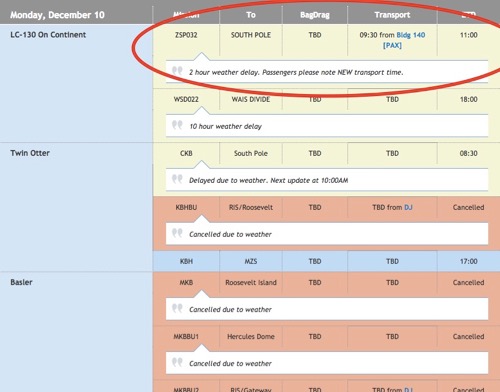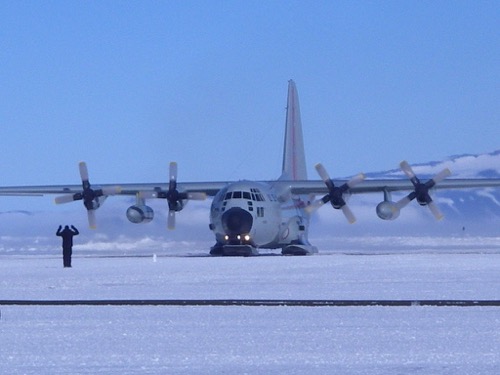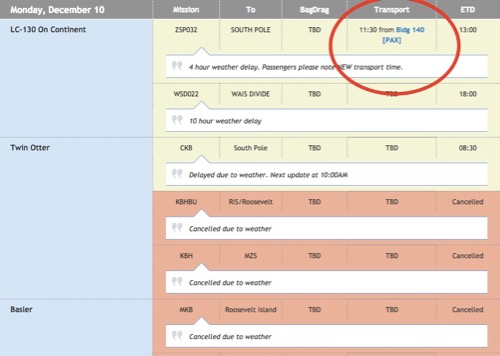Challenging and unpredictable weather
Click the Media link to see a short video on the variability of the weather here in Antarctica.
I'm here with a team of people who know a lot about weather. They are Meteorologists and Atmospheric Scientists. Their job here is to install and maintain Automatic Weather Stations (AWS) all over the continent of Antarctica. There are right around 130 AWS (placed by our team from the University of Wisconsin or entities or other nations) on Antarctica. As a comparison, there are about 50,000 weather observation sites in the continental United States. And remember that Antarctica is nearly twice the size of the continental United States. Having so few platforms to observe the weather in so few places makes predicting the weather here on Antarctica very challenging.
It is impressive that the weather prediction is as good and accurate as it is!
Flight delays
One of the consequences of the highly variable weather and the lack of precise weather information from all areas of the continent is that flights frequently get delayed or canceled. Since I've been here we've had numerous delays and cancellations on helicopters and fixed-wing aircraft. The most recent have been concerning our flight to the South Pole.

We will be flying to the South Pole on an U.S. Air Force C-130.

Is it frustrating?
I'm not at all frustrated. The reason they flights are delayed is to ensure that everyone (the flight crews and the passengers) are as safe as possible. The only thing that I DON'T like is taking the medicine that is supposed to help with altitude sickness at the South Pole. It is called Diamox and one of the side-effects of the medicine is insomnia. So, since I took it on both nights thinking I was flying to the pole the following day...I hardly slept either night. I am looking forward to going to the South Pole. And being told that I have to wait isn't the hard part. Wondering what the "downstream consequences" of these delays are the hard part.
Downstream Consequences
There are several things that may change due to these flight delays. The first is the PolarConnect event that was just scheduled.
I also now have the registration for the 12/17 PolarConnect event. If you are interested, you can register for that here.
The PolarConnect is my opportunity to connect LIVE with classrooms about what my team and I have been doing here in Antarctica and answer any questions in real time. I'm really looking forward to that.
But, the further that these delays push into the time at the South Pole the more challenging making that PolarConnect happen becomes. There are only two of us going to the South Pole and there is real work to be done there. Two AWS have to be serviced and the likelihood of those happening without delays of their own are pretty slim. So, the longer the delays last the more challenging the PolarConnect becomes because accomplishing the mission of servicing the AWS at the South Pole becomes more important in a shorter time window.
The other downstream consequence of having to stay at the South Pole until the mission is completed is that when I return home could be affected. It isn't a huge problem, I've been told many times that the dates are flexible and my family and I are prepared for that. But if everything went according to the schedule, I'd be home for Christmas.


Comments